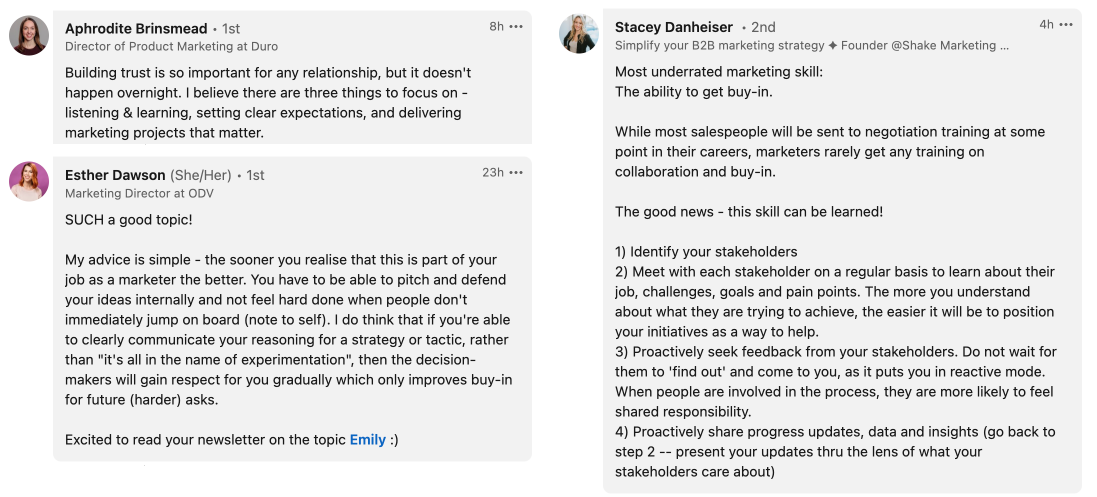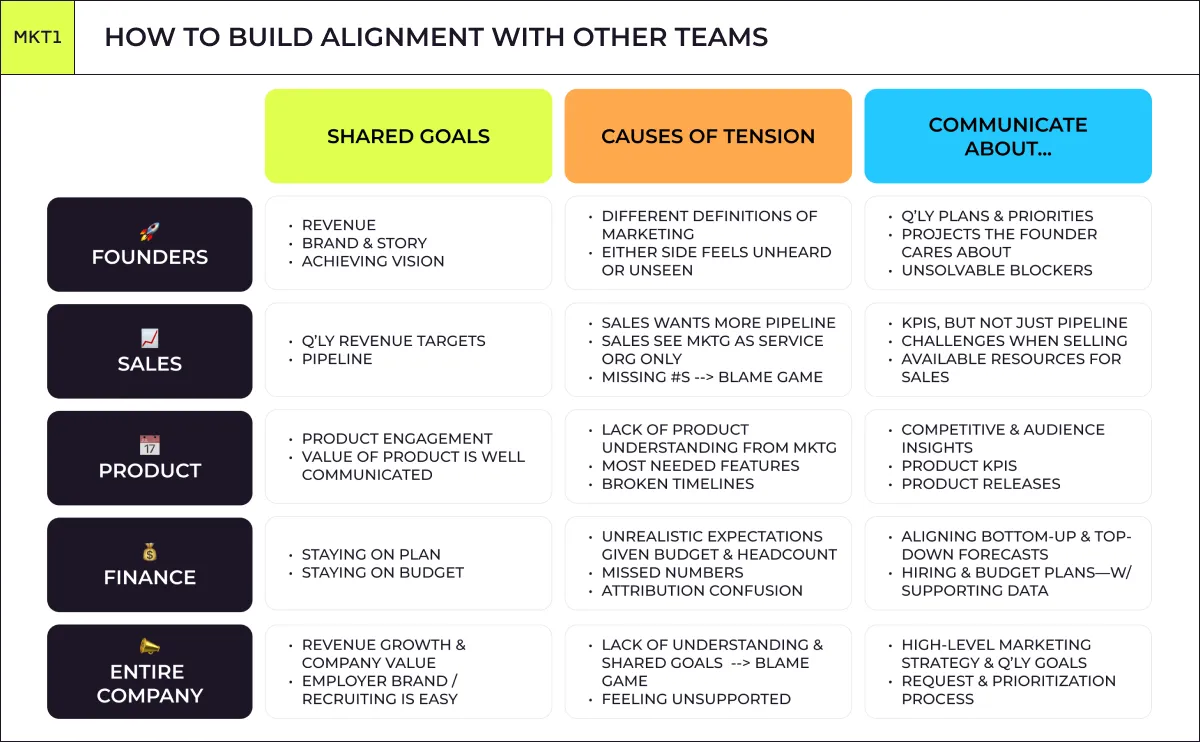Educating the rest of your company on marketing is often the hardest part of doing marketing.
This is ironic (don’t you think?). Marketing’s actual job is to understand an audience and communicate to that audience in a value-add way. Yet, when it comes to doing this internally, marketers often fall short–very, very short.
If I could turn back time to my marketing roles, I wish I had recognized these truths sooner:
- Marketing is misunderstood and often under-leveraged as a function.
- Everyone has an opinion on what marketing should and shouldn’t be doing.
- It’s hard to know exactly how marketing is impacting revenue–and no one will agree on attribution ever.
- Marketing is often thought of as an extension of sales, when it’s actually more like a product org.
These factors lead to scrutiny, recommendations coming at you left and right, the feeling that no one really gets what you do at your company, and a whole lot of tension between marketing teams, founders, sales, product, etc.
This tension holds you back from making an impact. Without getting buy-in and support from other teams, you won’t get the resources, collaboration, or results you need.
All that said, you’ll never get everyone at your company to stop asking you questions, sending requests, weighing in with opinions, etc. Nor should you. Some of these contributions can be really helpful. You, as a marketer, need to take control of the situation. You need to spend more time on “internal marketing” than you may think. And the sooner you accept and embrace this reality as a marketer, the faster you’ll succeed.
In this newsletter:
This newsletter is a companion to “Intro the MKT1 Method”, an overview of our core principles for building B2B marketing teams. The MKT1 Method is a great primer for how to communicate about marketing in a high-level, first principles way with other teams. Find the newsletter, video, and slides here.
This newsletter helps marketers market marketing internally (tongue twister intentional), and we’ll cover 3 main topics:
- Finding common ground with other teams
- Educating your company on marketing
- Sharing marketing’s priorities—to get buy-in and prevent last minute requests from dominating your marketing to do list
Thanks to our sponsors
We only include sponsors we actually recommend to our community and portfolio companies. If you are interested in sponsoring our newsletter, email us at sponsorships@mkt1.co
Closing Media – LinkedIn Advertising & Creative Production
Closing Media partners with companies like Headspace, Betterment, and Unity to fuel their paid media engines. We’re a small team of two focused on making your life easier with efficient, revenue-generating campaigns (on LinkedIn & Google) and fresh, high-converting ad creative.
Why MKT1 recommends Closing Media: Getting LinkedIn to be a successful paid channel takes experts like Max & August at Closing Media. I first worked with this team 5 years ago when I was an in-house marketing leader—we’ve since recommended them to many portfolio companies.
Offer: Reach out to Closing Media here & mention MKT1 to get $2,500 of free ad spend for your next campaign.
Ten Speed – Organic growth agency
Ten Speed is an organic growth agency for early and growth-stage SaaS companies like Bitly, Workvivo, and Visible. We tie into your marketing strategy, find low-hanging fruit, and grow your awareness, engagement, and MRR with proven SEO strategies and revenue-focused content.
Why MKT1 recommends Ten Speed: We’ve been referring Ten Speed to our portfolio companies for a couple of years now. They build strategies for your startup’s specific needs and understand the value of both fuel and engine.
Offer: Reach out to Ten Speed here & mention MKT1 Newsletter to get $1,000 off your first month.
RevenueHero
RevenueHero is the easiest way for marketers to qualify and route leads to sales rep’s calendar, right in your demo request flow, in email sequences, and sales hand-offs. Marketers and sales teams love RevenueHero’s built-in meeting hand-off, routing logs, native integrations with the GTM stack, custom branding, and insights at every step of the conversion funnel.
Why MKT1 recommends RevenueHero: We’ve been recommending RevenueHero since we wrote a newsletter on improving demo request flows last year. Making the marketing-to-sales handoff feel invisible to prospects improves conversion—RevenueHero makes this much easier.
Offer: Learn more about RevenueHero here & mention MKT1 for 15% off if you close by the end of April 2024.
Back to the post…
1. Finding common ground with other teams
The first step to better cross-functional relationships: recognizing you’re all on the same team. Cheesy? Yes. But helpful to remember? Also yes.
The second step: Understand your target audience. Sound familiar to how you do external marketing? Not a coincidence, it’s pretty much the same concept.
Much like you’d understand your ICP and their jobs to be done, you need to apply the same thinking to your internal stakeholders. Figure out what you and other teams both care about and what your shared goals are. Once you know what the other team or person cares about, it’s much easier to speak the same language.
It’s also helpful to recognize problem areas that come up between teams. Most of the time cross-functional relationships with marketing and other teams fail for the same set of reasons.
Finally, don’t bother other teams about stuff they don’t care about. Don’t give every last detail. Much like you should think of communicating with prospects and customers as a value exchange (if you don’t have anything useful to say to them specifically, don’t say it), apply the same principle internally. Share the stuff that’s in the venn diagram of things you both care about and need to know.
At the risk of stereotyping teams, I summed all this up for you in this diagram…

Beyond what’s in the chart, here are a few things we’ve learned over the years:
- Founders usually care more about a couple of specific areas of marketing, not all areas. Some care only about the “fuel” (brand, content, etc), some care just about the engine (KPIs). Some think marketing is just paid acquisition. Figure out what that thing is, ideally in the interview process.
- Marketers often forget they need to be friends with finance (or whoever owns the budget if you’re at an early-stage company). You need to spend a lot of time with finance, so they don’t think you are just like sales and so you can get the headcount and budget needed.
- Attribution issues plague relationships between marketing, sales, finance, and even founders. Remember in these conversations, you all want to drive revenue and grow. Marketing and finance might care about efficiency more than quota-carrying reps. And attribution is not a perfect science. More on this topic in this newsletter.
- There are some ownership gray areas between product and marketing, especially at startups with self-serve and product-led growth motions. Recognize what they are and make sure there are clear owners and clear stakeholders when changes are needed. These areas include: sign up flows, onboarding, product adoption, monetization goals, in-product announcements, help content, etc.
- Be a human and act genuinely curious whenever possible: When you have an opportunity, ask about challenges people are facing, priorities, blockers, what’s up next, etc. If you take an interest in what others are working on, you’ll get the same thing back in most cases. This additional context will also help you better understand your audience and tailor your “internal marketing” to them.
- Marketing will also work closely with teams not in the diagram, like recruiting (on hiring and employer brand), design (sometimes sharing resources), customer success (customer experience, enablement content, lifecycle marketing). The same principles apply: find the common ground and speak in terms of shared goals.
2. Educating your company on marketing
While a lot of people try to be “marketers” and pretend to understand how marketing works, most of your coworkers have no idea what you do and what your marketing jargon means. That’s not meant as an insult to them, but instead as a reminder to you to zoom out when talking to other teams.
Sure, your co-workers see some of the content you put out, glance at reports that show progress, and may know their main point of contact on the team, “I go to the product marketer, not the growth marketer”. But if you ask everyone for a rough job description for people on the marketing team most can’t give it to you. If you ask them what marketing does, everyone will have a different answer.
The rest of your company doesn’t need to know all the details, acronyms, and distinctions. But it’s really helpful when they understand what marketing does at a high-level. This allows you to move faster on the day to day work, set goals and priorities with less pushback, and collaborate more effectively.
Here are the 3 concepts I explain most often to founders and non-marketing leaders—the concepts usually cause lightbulb moments. Almost everyone in your company can benefit from understanding these things. For more on these principles, check out our MKT1 Method newsletter.
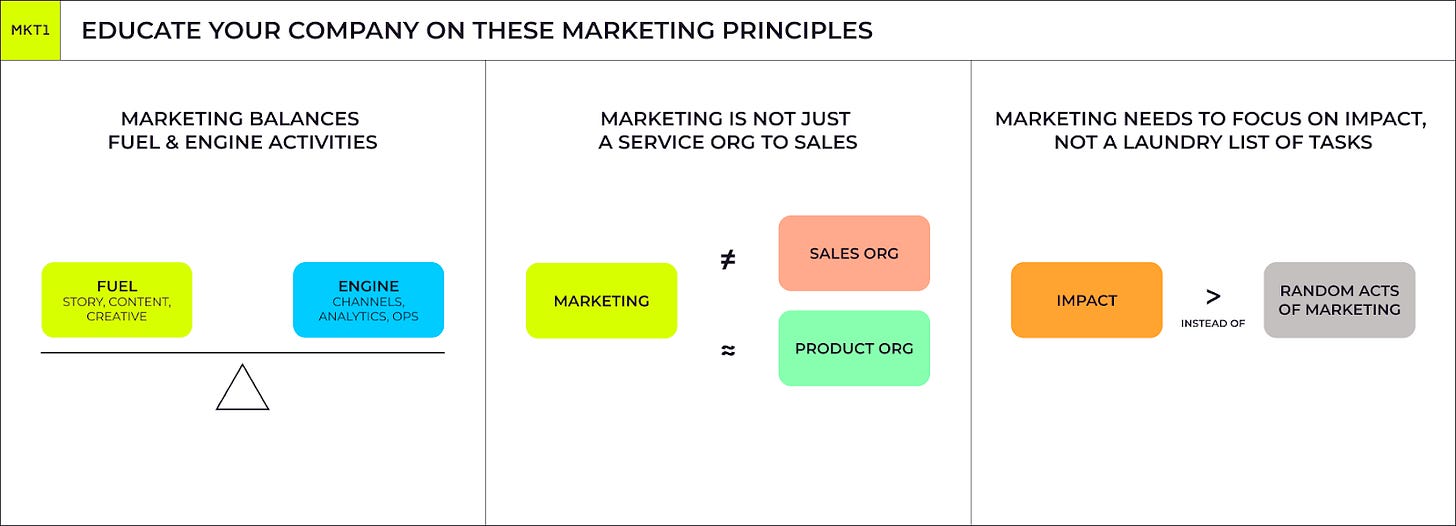
Concept 1: Marketing needs fuel and engine
Most people in your company don’t care about the nuances of what product marketing, content marketing, demand gen, etc do. And as I mentioned, most of your co-workers probably think marketing is mostly just fuel or mostly just engine (meaning they care more about one side of marketing).
- One of the most valuable ways you can explain what marketing does to the rest of the company is to explain the fuel & engine framework.
- To build a successful marketing function you need to produce great fuel and craft a well-running engine.
- Your fuel needs to be custom-made for your engine and your engine needs to be custom-made for your fuel.
- You are probably over-indexing on fuel or engine, so understanding and explaining this imbalance can go a long way in explaining why your priorities are set the way they are.
Concept 2: Marketing isn’t sales, it’s actually more like a product org
Marketing makes it possible to drive step-change growth and efficiency across your entire GTM org.
- Sales orgs grow relatively linearly with revenue, while marketing can be exponential.
- If you build a marketing org as simply a service organization to the sales org, you’re limiting your company’s potential.
- It’s also hard to get great marketers to join and stay at the company when marketing isn’t valued.
Marketing orgs and sales orgs actually look and operate quite differently. A better mental model for building a marketing org is building a product org (by that I mean eng, product, and design).
- Like product, marketing should be multidisciplinary (fuel & engine!).
- Marketing should think in terms of short-term goals and long-term projects.
- Marketing also builds “products” for a specific audience (your website and your content are products too!) More on these differences in this newsletter.
Concept 3: Marketing must prioritize impact–which means not completing every request
Marketing simply can’t keep doing the same things or make incremental improvements and expect to have breakout growth.
- Marketing needs to determine the best way to drive growth, set goals to hit that, and then follow these plans.
- Marketing needs to educate the company on how they are planning and prioritizing, so it doesn’t seem like you’re always saying “no”.
- You should only break from your marketing goal for a random act of marketing when it truly makes sense—not because your founder heard about something on a podcast, your sales team begged you to do it, your investors saw a competitor do something, or you got a Slack request at midnight.
3. Sharing marketing’s priorities
Set marketing strategy & goals–and share them
The first step to sharing marketing’s priorities is making sure you have priorities and good reasons for those priorities.
This means marketing must set goals. While it’s ideal if the whole company sets goals and marketing’s goals ladder up to them, marketing needs to set goals no matter what.
Why are goals so important for marketing specifically?
- Marketing has a massive potential purview. Ideally, marketing focuses on both long and short-term revenue growth, top-of-funnel growth and full-funnel conversion, multiple channels, handling requests from all teams in the company, etc.
- There are infinite things marketing can do. So, the second hardest thing (besides marketing “marketing” internally) as a leader is prioritizing. The best way I know to prioritize is to set goals.
- You can’t expect other teams to get on board with what you’re doing if you can’t articulate what you’re doing and why.
Set 4 types of goals
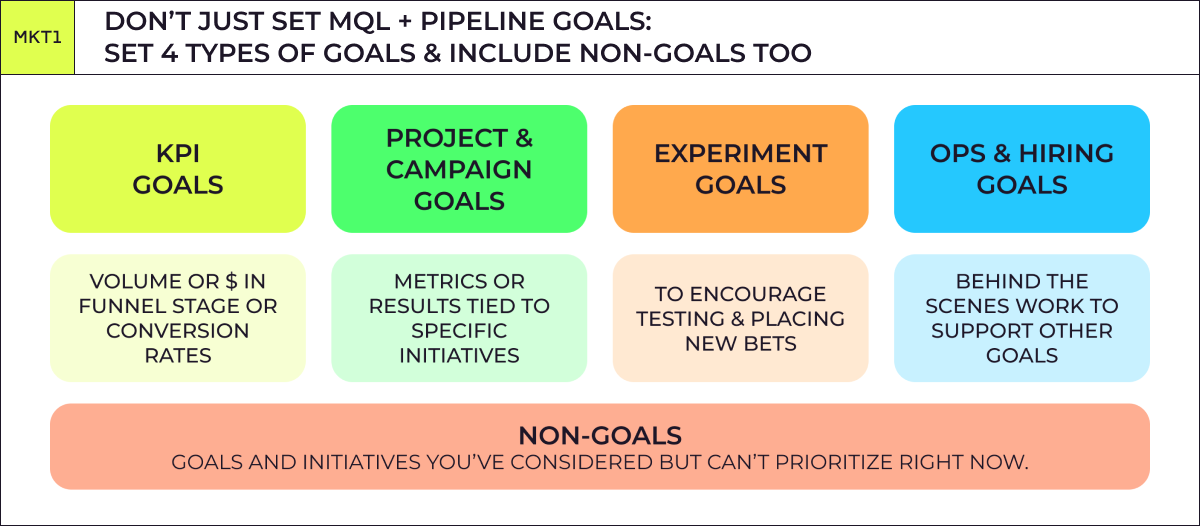
Hopefully, you now recognize you need to set goals. But, don’t think you can just set some KPI goals and call it a day. That’s not the point here.
You need to make plans in advance for how you will drive growth and hit those metrics (obviously leaving some room to adapt plans as needed to meet the moment, adjust for audience learnings, etc.) The best way to do this is to set 4 types of goals (the timeframe of these goals can be quarterly at early-stage startups, rather than annually):
- KPI goals – Don’t forget to set conversion rate goals in addition to volume goals!).
- Project goals to plan for the big initiatives that will drive short & long-term growth.
- Experiment goals for tests so you make sure you make room for new bets.
- Ops goals, which can take a lot of time, so it’s important to call out and make time for them.
The importance of stating non-goals
Making a list of things you can’t do this quarter or year is almost as critical as saying what you will do. This shows that you’ve considered everyone’s thoughts and ideas. It gives you a chance to explain and give the why behind the conscious prioritization decisions you made. If you don’t do this, you’ll just get the same requests and questions over and over again.
To set these goals, make sure you:
- Gather input from other teams
- Identify your marketing advantages first
- Understand what growth levers you are focused on
- Create focus storylines (aka perceptions) to guide your “fuel” efforts
- Map your major campaigns in advance
- Identify the best channels for your audience and GTM motion
(All of these links to go to other MKT1 newsletters for deep dives on each topic)
Set up a cadence for collaborating with other teams
To use the same metaphor I use for external marketing, your goals and plans are your “fuel” for internal marketing and sharing them via Slack, meetings, Looms, etc. is your “engine”.
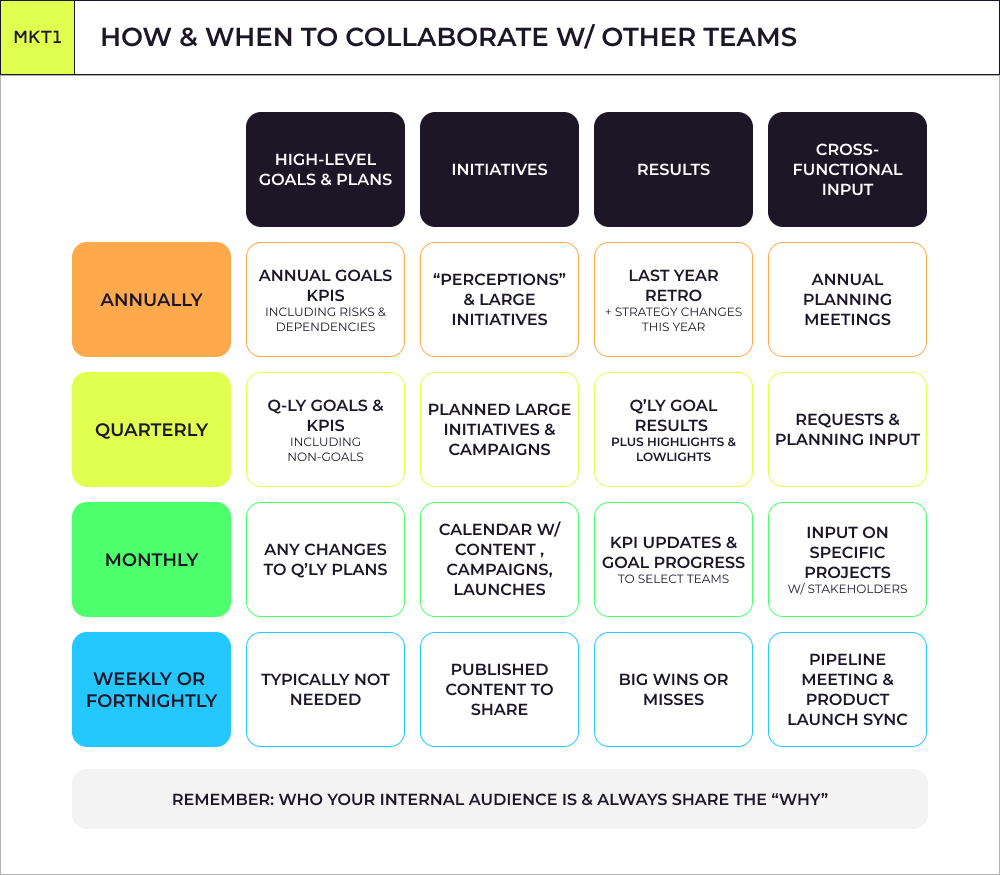
Recognize that just like with external marketing, it takes time to get the distribution to other teams right, so you’ll have to do some trial and error.
Here are some tips for communicating with other teams:
- Find a format that works, and rinse and repeat: Have a template Slack post, a Loom format that you use weekly, a standard deck format you share at all hands meetings or even with the board, etc. This makes it fast for you to create and easy for other teams to digest and see progress.
- Always explain the why: Link your goals back to your marketing strategy and company strategy too. Remember: what might be obvious to you is notto your coworkers outside of marketing.
- Use the GACCS brief for internal alignment on projects. Include the goals (not just the goal or KPI it ladders up to, but also the why), the audience you are targeting, the creative or fuel, the distribution channels or engine, and the stakeholders involved. Newsletter on GACCS (guest post in Lenny’s Newsletter).
- Be clear on timelines for results: Some marketing work might result in immediate impact, while other things may take weeks or months to drive results. Make sure stakeholders understand the time horizon for each initiative.
Standing meetings
It’s worth a paragraph and not just a bullet to mention: you will need to check in regularly with product, sales, founders, and team leads regularly. It’s typically best to have recurring meetings for product roadmap and launch updates, to review pipeline and campaigns with sales, and for GTM leaders and product to talk about customer feedback and needs. Don’t skip these. The status updates during these meetings are important, but those can happen async. The goal during meeting time should be relationship building, which works better when you meet regularly, not just when there are fires.
Read this far and not a subscriber yet? We send monthly deep-dive newsletters just like this one.Subscribe
What to do when you get ad hoc requests from other teams?
Your best defense for random requests from founders: Sharing your goals & plans.
If you follow the guide to communicating with other teams above, they will understand what you’re focusing on and why. They will also understand that on a quarterly basis they’ll have an opportunity to share high-level requests, and monthly they’ll be able to give input on projects.
But, you’re still going to get random requests. How do you handle that?
- Have a request process. I’m a huge fan of using Asana forms that feed into an Asana project. Taking these in Slack is pure chaos. Plus, this makes the requester put some thought into their asks vs sending you millions of ideas on a whim.
- Actually triage the requests. Once you have a request list, triage it on a quarterly or even monthly basis. Gather more context if needed and then indicate the priority. Take time to write a thoughtful reasoning for why you’ve prioritized each request, especially for the popular ones.
- Ask for problems not solutions, especially from sales. Get to the root of why the requester is asking–this often leads to faster, easier, and more effective solutions. On a quarterly basis, prioritize the top problems sales are facing, and then come up with solutions together for how to solve them. If you don’t do this, you’ll get a request for a million case studies and PDFs that will never actually get used.
- Practice what you preach: When working with other teams, make sure you go to them with problems and not just solutions too. I.e. Go to designers and explain that a page isn’t converting, and then let them do what they do best and design a solution.
- Recognize it’s a give and take. If you always say “no”, co-workers are always going to say “no” to you right back. Strike a balance. Have a process for urgent requests–but don’t let people cry wolf and send you too many of these.
- Point to your list of goals, non-goals, and prioritized cross-functional requests when needed. All the things mentioned in this newsletter will help you in these moments!
Be kind and empathetic in your “pushback”.
Here’s an example: “We’re not going to prioritize this right now b/c we are pushing towards [x goal or initiative], but it’s on the list to review on x date.”
If that doesn’t work, you can say, “Do you think this should take precedence over other priorities? We’re open to hearing why and changing our mind”
Have a better way to say this? Tell me in the comments.
What to do when you can’t get buy in or resources?
On the flip side, if you are making marketing requests, follow the same process you expect others to follow:
- Include supporting data and context when you ask for things.
- Follow the right processes. Don’t be a pest.
- Offer to run a test if people aren’t bought into an idea all the way.
- Make a list of what goals and priorities you could tackle if you had that extra hire or budget you’re requesting.
There are some requests that are commonly pushed back on by other teams–be it finance, founders, sales, or product. Here are some of those requests with a MKT1 Newsletter you can use to educate your co-workers on the why behind your requests:
- Moving your website to an easily updatable CMS
- Hiring more “fuel” people to balance “engine” people and vice versa
- Bringing on agencies
- Setting proper growth targets
- Hiring marketers instead of more SDRs (note this post is a bit dated due to all the AI products available, so the case is even stronger now!)
Takeaways
I wish I had a silver bullet for working cross-functionally. I don’t–and I don’t think anybody else does either.
But I will say, it’s never too soon to get better at the “internal marketing” part of your job. Marketers that work effectively cross-functionally go very far—it often gets you more credibility than the external marketing you do. This is part of your job, so treat it as such—even if you have a dedicated internal comms person or are an IC—you can share context, build cross-functional relationships, and explain marketing no matter your role.More from MKT1
More tips on building cross-functional relationships from other marketers
Thanks to everyone who shared their tips on LinkedIn, if you want more ideas on working cross-functionally and educating your company on marketing check out this post (and add your ideas) and this post.
